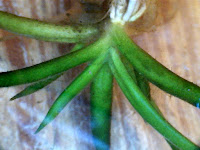On Sunday 10th March, a hardy group of us set off to do our recce dive of the Llugwy - by way of training for the River Conwy project - at Cobden's Pool. Permission courtesy of Roland Jones, Prop. Cobden's Hotel. Access was via the little beach just below the carpark.
Equipment consisted of a variety of ropes that Liz mostly brought, including floaty ones, and a heavy one if needed. Mike brought a milk crate to lower the gear down to the beach, but as this was too small, we used an old rucksack and trussed it all up with carabiners and figure 8s, of which we had a carrier bag full. We had an interesting collection of grapples, if we decided to practice anchoring ourselves to the bottom (which we didn't) - including a short handled garden rake and a 3-tined handplough (! lethal), an ice axe, and various assorted other bent metal implements.
The first thing was to set up some grabropes in case the current was so strong we were swept downstream. Nigel (my other half) waded across various small tributaries and attached floaty ropes to trees and bushes.
That done, we lowered the gear down the wall onto the beach, devised the dive plan, and then it was 'Who's going in first?' The current looked pretty vicious - a couple of knots? - and from the bridge Liz measured the depth with a tagged rope as being 3ms....not exactly the deepest dive in the world, but that wasn't why we were doing it!
Mike and Kathryn took the plunge and as vis was quite good (at least 3ms!) we could see them swim down stream, past the grabrope (huh?!) to the large boulders guarding the ouflow.
"Are they going to get swept away??" Liz and I waited with baited breath......but as it was only about 1-2ms depth the only (?) hazard was going to be crawling on hands and knees with bums in air. There were some great shots of Mike's fins as he did a handstand.....sort of reminiscent of a whale's tail fin...but out of respect for Mike I have not included one here.....
Turning round, they then ventured into the midflow of the current and, standing on the bridge looking down, we could see them swim upstream, through the defile, under the bridge, right up to the white water rapids!
Then it was Liz and my turn. We didn't bother with the shallow bit, more interested in seeing how to deal with the current. We were pleasantly surprised to find that the current was only fast in the top metre of the water column and we could doddle about without much difficulty below that.
The 'landscape' below was very interesting, mostly blue/grey cobbles, and contorted bedrock covered extensively in places by green and purple algae. We followed channels through the boulders and bedrock, and Kathryn found a small fish under a stone (stone loach/juvenile trout?), Liz and Kathryn saw a juvenile trout hanging about by the beach, and there was a patch or two of white sponge deeper within the rocks, plus some weed and grass type flora.

So not a lot of wildlife, at least, not on a cursory glance. And as our prime objective was to practice skills, we didn't do much hanging around quietly, which will be essential for seeing anything in the wild.
The prime beauty of the site for me was the sculpturing of the rocks by the currents and eddies into holes and chasms, in which interesting and colourful collections of pebbles had gathered.
It was exciting swimming up underneath the rapids and we got some great underwater footage of the white water swirling through and over the boulders. As we felt this would be a great incitement to others to plunge in with us, I have now learnt how to capture a single still frame from a video of rushing water...
The temperature was 8C and half an hour was long enough to stay in the water, so we went to derig the ropes. As the rope across the main tributary needed to be released in water, Liz and I allowed the current to gently float us over to it, but the current as it swept round the corner was very fast and the water was shallow, so it was here that the strength of the river could be keenly felt, necessitating hanging on firmly to tree roots! And the grab rope came in very handy at this point too.
During the dives we picked up litter - which included a bicycle bell, a tin can, a yoghurt top, a solar reflector...and underneath there were various heavy rusty iron artefacts that we couldn't identify.
All in all, over lunch at Cobden's hotel, we felt it was a successful recce, and apart from Nigel getting soaked in his riggers boots (not meant for underwater we decided), we felt heartened that we would be able to move on to the next stage, which is the actual Afon Conwy.
Kathryn is devising a recording form which anyone will be able to fill in after a dive, noting location, type of riverbed, flora and fauna and anything else of note.
The river dive project needs more divers and cameras, and more people willing to mess around on river banks with ropes and help get gear to the sites. The thought of summer banks, quiet splashing of voles and trout, and picnics, and pubs, springs to mind....as well as traipsing across moors and abseiling down gorges....anyone up for it?



































